|
|
Monarque

|
|
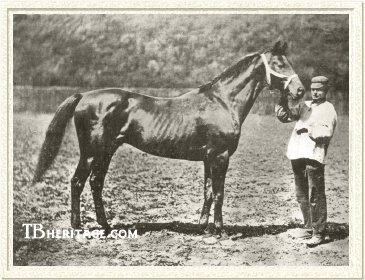 |
|
|
Monarque, a versatile and durable winner on the turf, was the most successful stallion in France in the mid-nineteenth century. He established a long-lived sire line in France, and got many good winners of races in France, England and Germany, the most noted being Gladiateur, one of the best racehorses in the history of the breed.
|
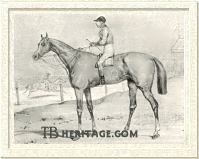
Poetess
| |
His dam, Poetess (1838), was by the imported stallion Royal Oak, a modest winner in England, and out of imported Ada, by Whisker. Both her parents, purchased in England, were influential in the development thoroughbreds in France. Royal Oak, who had been bought and imported by Lord Henry Seymour, "Father of the French Turf" in late 1832, and later stood at French government stud farms, was the most important stallion of the period there, getting many winners and good producing daughters. Ada (Family 19 - a) was imported by Seymour, and for him bred several good daughters, including Poetess and her half-sister the stayer Miss Annette (1830).
|
Poetess was celebrated for her win of the Prix du Jockey Club, beating the colts. She also won the equivalent of what would become the Prix de Diane, the New Betting Room Stakes (then an important race in France), and was third in the Prix du Cadran behind Nautilius and Fiammetta. Miss Annette (1830, by Reveller), won the Grand Prix Royal Oak (later Prix Gladiateur) in 1835, the Prix du Cadran in 1837, and other races, was later the dam of the famous race mare Annetta, and through her, second dam of three French classic winners; the American runner Wise Times (1983) was a tail-female descendant from Ada and Miss Annette.
Poetess was retired to Seymour's Glatigny stud, near Versailles, but Seymour's stable was liquidated in June of 1842, and she was purchased as a hack by Baron Lecoulteux, who later sold her, for just 100 francs, to Alexandre Aumont, who had stud farms at Victot and at Dangu (the latter purchased by Count Frédéric de Lagrange in 1857).
For Aumont, Poetess bred Hervine (1848, by Mr. Waggs, another imported English horse), the most celebrated mare on the French turf in her time, whose wins included at age two the Prix de la Ville at Chantilly, and at age three the Prix de Diane, the Prix du Printemps, and many other high-class races, and at ages four and five the Prix du Cadran, among other important contests. Hervine later produced the grand staying filly Mon Etoile (1857, by Fitz-Gladiator), winner of the Grosser Preis von Baden, the Prix Gladiateur and Prix Rainbow and other races, later dam of Cambridgeshire winner Peut-Etre; Minerve, dam of French Oaks winner Serpolette; and New Star, dam of Grand Prix de Paris winner and great stayer Tenebreuse. The famous mare Plaisanterie (1882, winner of the fall double in England), the great runner and sire Tracery (1909), and many more excellent horses descended in tail-female from Hervine.
Poetess was covered successively by three stallions in 1851: The Baron, Sting, and The Emperor, the latter the last cover. The result was the bay colt Monarque, her last foal, born in 1852. The next year, 1853, Poetess experienced a grotesque death -- having been left tied up and unattended, she was taunted by some kids, and became tangled in the rope, falling, and breaking her shoulder.
The Emperor
Monarque's true paternity was debated for years -- it probably still is. Cesarewitch and St. Leger winner The Baron had been imported in 1849, and Goodwood Cup winner Sting (by Slane) the year before, both purchased by the French government for the state studs. Both The Baron and Sting were successful stallions in France. The Baron got Zouave, Dame d'Honneur, Étoile du Nord, La Maladetta, Pergola, Auricula, and a host of other good runners, in addition to Comtess, the dam of the great racehorse and important stallion Mortemer, and Vermeille, the dam of Vermout and his famous siblings. Sting got a number excellent runners as well, including the great filly Jouvence, the excellent Échelle, Lysisca, Moustique, and many others. Most turf writers of the time, and afterwards, believed The Emperor got Monarque, although there was a faction that claimed Sting was his sire, based "on too many points of resemblance."
|
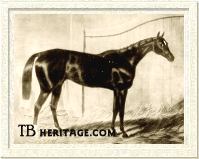
The Emperor
| |
The Emperor was bred by the Earl of Albemarle, and was by Defence, and out of a mare by Reveller. Albermarle won the Two Thousand Guineas with Ralph, the year The Emperor was born. As far as can be determined, The Emperor only ran four times in his career. At age three, 1844, he won the Emperor of Russia's Plate (Ascot Gold Cup) over 2-1/2 miles, beating a really top field that included Corranina, Ionian, Poison (Oaks winner of the previous year), Attila (Derby winner in 1842), and the Bishop of Romford's Cob; The Emperor received weight from almost all. His other race that year was the Cesarewitch, won by Foig-a-Ballagh, in which he ran unplaced. |
At age four he was back at Ascot to run in the Royal Hunt Cup in a big field of 29, and was unplaced. A few days later he ran in the Emperor of Russia's Plate (Ascot Gold Cup) again, and won it by two lengths, beating Foig-a-Ballah, who was weighted evenly with him, with the great, but aging, Alice Hawthorn third, and Cowl, irreparably lamed in the running, last.
He stood several seasons for Albermarle, and in 1850 was purchased by the French government. In England he left one mentionable colt, Lord Albermarle (1850). He made two short seasons in France, 1850 and part of 1851, before being kicked by a mare and dying of kidney failure.
His truncated career as a stallion still left some good runners, in addition to (probably) Monarque. Allez-y-gaiment (1852, from Francesca, by imported Cadland), won the big juvenile race, the Grand Criterium, beating Monarque, and at age three won the Prix du Conseil at Moulins. Lindor, from the same crop, was a promising colt, but he broke his leg in the running of the Prix du Jockey Club. A daughter, Géranium, won the Prix du Printemps at Paris for her owner, Count de Blagny. Monarchist was a good winner in provincial venues.
There were two other colts with disputed paternity, of which The Emperor may have been the sire. One was Peu d'Espoir (1852, also possibly by The Baron or Sting), a good runner who faced a grueling four heats to beat French Oaks winner Ronzi in a match race, running a total of 8,000 meters for a 3,500 franc purse. The second was Baroncino (1852, from Geneviéve de Brabant; also possibly by The Baron). Baroncino, owned and raced by Baron Nathan de Rothschild, won the Prix de l'Empereur (Prix Lupin) in 1855, and was second to Monarque in the Prix du Jockey Club. Taken to England, Baroncino won the Goodwood Cup; he was sold there, and did not return to France and apparently did not do much afterwards on the turf or at stud.
The Emperor left some daughters that bred on, including Pauline (1851) had three daughter from whom descended such horses as Prix de Diane winner Barberine (1882) and German Derby winner Kunstlerin (1876).
Monarque on the Turf
Poetess dropped Monarque at Aumont's Haras Victot in 1852. Monarque was a big, handsome 16 hand tall horse with an attractive head and a deep, sloping shoulder. On the turf he proved very durable, versatile and courageous. He won at all distances, often carrying the heaviest weight, and raced between the ages of two and six.
His debut on the turf was in 1854, in the Grand Criterium, the big juvenile race in France at the time, where he ran second to his stablemate, Allez-y-gaiment, also by The Emperor.
The next year he was undefeated in ten races in France, shipped to England to run unplaced twice -- Goodwood's Steward's Cup, carrying top weight, and the Cesarewitch -- and then returned to France to win three more races. His wins that year included the Poule d'Essai, the Poule des Produits, the Prix du Jockey Club, the Grand Saint-Léger de Moulins (giving Allex y-gaiement 14 pounds), and the Derby Continental at Ghent.
At age four he won five races, including the Prix du Cadran, the Prix du Pavillion, and the Prix Impérial at Paris, but ran second to Ronzi in the Grand Prix Impérial (over 4,000 meters that year at Champ-de-Mars, later Prix Gladiateur), giving her ten pounds. Aumont took him and his stablemate Peu d'Espoir back to England to run: Monarque could only run third at Goodwood, in both the Steward's Cup and the Goodwood Cup.
In October of 1856 rumors began to circulate regarding the possible auction of the ailing Aumont's horses by the newly founded Tattersall's France. Instead of a much-anticipated public sale, it was announced that Count Frédéric de Lagrange had purchased Aumont's entire stable, including Monarque and the future star Mademoiselle de Chantilly (then age 2), with an option for Lagrange to purchase all produce from Haras Victot, excluding only Hervine and her produce. This was the count's big debut in the world of racing, and he became the most influential of French owners and breeders for several decades in the nineteenth century; in 1857 he established the famous Haras Dangu, partly purchased from Aumont. Aumont's trainer, Englishman Tom Jennings, followed his horses, becoming Lagrange's trainer in England, while his brother Henry trained the stable in France.
In 1857 Monarque, age five and now owned by Lagrange, began by running third to that year's Prix du Jockey Club winner Potocki and Marville in the Prix de la Ville in Paris, giving away gobs of weight. He then won the Prix des Pavillons, beating Ronzi, and the Prix des Haras, beating Lion, giving away four pounds. A week later he met Lion in the Prix de l'Administration, giving the younger horse eleven pounds: he won the first heat by a head, and the second when Lion shattered his pastern heading for home. He then won several royal plates in the provinces, including Boulogne's Prix de l'Administration des Haras and Grand Prix Imperial, before the Prix de l'Empereur at Chantilly, won by Fisherman, where he did not place. |
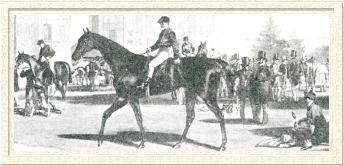
Monarque at Longchamp, 1857; Henry Jennings and the count to his right
| |
Monarque met Potocki again in the Grand Prix Impérial (later Prix Gladiateur, re-named for his famous son) at Longchamp (moved from Champ-de-Mars and lengthened to 6,000 meters), beating him easily.
|
He was sent back to Goodwood in England for a third time. This year, he won the Goodwood Cup, beating Richter, Fisherman, and the American mare Prioress, avoiding the tangle created by the favorite, Gemma di Vergy, Gunboat and Florin during the running.
At age six, 1858, Monarque was taken to England to run. He won the Newmarket Handicap, but several weeks later, at Epsom, he broke down during the running of the Great Metropolitan Handicap. He had proved to be a durable, high-class runner, one of the best ever bred in France, and would pass on his courage and endurance to his offspring.
Monarque in the Stud
Monarque was retired to the count's newly established Haras Dangu, and remained there until his death at age 22 in 1874, after which a memorial tomb was erected in his honor in the chateau's park. During the Franco-Prussian War, when Lagrange sold almost all his bloodstock and leased the rest to Joachim Lefèvre, Monarque was one of the few that remained at Dangu, which was occupied by the Germans. According to one story, Monarque was largely neglected during the years of occupation -- the count himself suffered a number of indignities at the hands of the Germans while remaining in residence at Dangu. When the Germans finally left, Monarque, who had been put in pasture with no attention, was seriously lame from lack of trimming, with diseased hooves.
He got many great runners that won both in France and England, and several good sire sons, who continued his line well into the twentieth century, and some good-producing daughters who were influential in the breed's history. His most noted offspring was the nineteenth century's greatest racehorse, GLADIATEUR. But Gladiateur, who spent most of his breeding years in England, was not the one to continue the line; that was left to Monarque's son CONSUL (1866), sire of two Prix du Jockey Club winners, and of Fripon (1883), great-grandsire in tail-male of the great French crack and two-time leading sire Sardanapale (1911). Monarque's daughter, REINE (1869), won both the One Thousand Guineas and the Epsom Oaks in England, proving to be the best filly in Europe that year. His daughter, LA FAVORITE (1863), a pretty good runner herself, produced Flageolet, the top juvenile runner in Europe in his time and a good stayer in France and England and the first French-bred and owned horse to head the sire's list in England.
Monarque's first crop included a big juvenile winner, HOSPODAR (1860, from Sunrise, by Emilius). He was one of Monarque's few good juvenile winners that failed to train on well. In England he won both the Clearwell and Criterion Stakes for Lagrange at Newmarket in 1862. He did not place in any of his major engagements at age three, including the Two Thousand Guineas, the Derby, an Ascot biennial, or the Cambridgeshire. He was then sold for a very big sum, 50,000 francs, to the Count de Dampierre, and when the count was killed in 1870 in the Franco-Prussian War, he passed into the ownership of Gustave Fould, and then J. Oller, the inventer of the Pari Mutual in France.
Another good juvenile from Monarque's first crop was LE MARECHAL (1860, from Lady Lift, by Sir Hercules). He won England's prestigious Gimcrack Stakes for juveniles, and the Zukunfts Rennen in Germany. At stud in England, he got Cicely Hacket, the dam of Hackness, a good producer whose son, Hackler, was a leading sire of jumpers in the U.K.
Others in the first crop included FORNARINA (1860, from Fradulent by Venison), the dam of a good runner Gift. Another in this crop was L'AVENTURIERE (from Constance, by Gladiator), whose tail-female descendants include a great many stakes winners, including Irish Derby winner Haine and the outstanding matrons Martine Boileu (1965), Macchietta (1946), and Blue Tit (1908) and her daughter, Goodwood Cup winner Teresina (1920). Constance was also the dam of FIDÉLITÉ (1861), LA FAVORITE (1863), LE SARRAZIN (1865), and BLANCHE (1866), all by Monarque. Another filly in Monarque's first crop was VILLAFRANCA (1860, from Miss Gladiator, by Gladiator), a full sister to Gladiateur (see below).
Monarque's second crop included two good running fillies and a colt whose racing career was cut short.
BEATRIX (1861), from Miss Ion, by imported Ion, won the Prix du Cadran for Lagrange in 1865, the first of five Monarque offspring to win that race in six years (1865-1870). Her brother, BOULOGNE (1866) would win the same race in 1870; Boulogne also won the Grand Prix de laVille at Lyon (in 1869), and in England, the Bentinck Memorial at Stockbridge (in 1870) and the Newmarket Derby (in 1869). A third foal by Monarque out of Miss Ion was HENRY (1868), a juvenile in the lot of horses sold by Lagrange at Tattersall's in 1870; he was purchased by Joachim Lefèvre for 35,437 francs. Henry was an outstanding stayer: in England, age three, he won the Ascot and Newmarket Derbies, and at age four won the Ascot Gold Cup in England, and the Prix Rainbow in France.
Another Monarque filly of 1861 was FIDÉLITÉ (from the Gladiator mare Constance, and so a sister to L'AVENTURIERE). She and her dam were part of the short-lived partnership Lagrange had with Pol Nanquette, called Le Grande Ecurie (the "Big Stable"), and she was sold when the partnership dissolved in 1862, when a yearling. She was purchased by Henri Delamarre, and in his ownership she won the Prix Jouvence and was second to Ninon-de-Lenclos in the Grand Prix de l'Empereur (Prix Gladiator over 6,200 meters) in 1865. When she retired to stud she produced Prix Hocquart winner Filoselle and Fifine, a winner of two small races who was later dam of Fine Mouche, whose female line was successful in Australia. Filoselle (1873, by Vermout) produced the stakes winner Fifre and a daughter, Foscarina, whose daughter, Italian Oaks and St. Leger winner Wistaria (1907, by Galeazzo) bred on.
The colt GÉDÉON (1861), from Garrene, by Freystop, was another in that crop. He was another purchase at the sale of Le Grande Ecurie, and cost the Duke Auguste de Morny 4,000 francs. He won the Prix de Longchamp (Prix Hocquart) for the duke, but during the Prix de Chantilly, taking on Vermout, he dislocated his shoulder, ending his career on the turf.
Monarque's most famous offspring was born in 1862: GLADIATEUR, a brother to VILLAFRANCA, out of Miss Gladiator. Monarque got another good one that year in the colt LE MANDARIN.
|
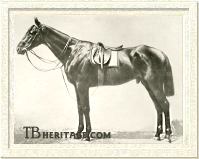
Gladiateur
| |
GLADIATEUR, born in 1862, was from Miss Gladiator, by Gladiator (sire of Sweetmeat and Queen Mary in England, and Mademoiselle de Chantilly, Fitz-Gladiator and other good ones in France), who had won one race and was retired to stud due to injury. Purchased by Lagrange from Thomas Carter because of her Gladiator blood, she was first bred to Peu d'Espoir, producing a filly, Fillle-des-Jones in 1858. Bred to Monarque, she dropped a filly, VILLAFRANCA, in 1860. Villafranca later won the Prix de Longchamp, later Prix Hocquart, for Lagrange.
|
After being barren in 1861 Miss Gladiator was again put to Monarque, who had conceived an inexplicable aversion to the mare, and refused to breed her, prompting a bait-and-switch strategy by the stud groom. To induce Monarque to cover Miss Gladiator, he was left "for a long time" in the presence of the mare Liouba (who to his cover that year would produce LE MANDARIN), apparently a mare he liked, and when he was ready, he was blindfolded, and was put to Miss Gladiator. The result of this cover was GLADIATEUR.
A big, sweet-tempered horse, Gladiateur won all but one race in his three-year-old season in England and France, including the English "Triple Crown" races, the Grand Prix de Paris, the Doncaster Stakes, and the Prix du Prince Impérial, among others. The next year he took the Derby Trial Stakes, the Claret Stakes and the Ascot Gold Cup in England, and the Grand Prix de l'Impératrice (Prix Rainbow) over 5,000 meters, among other races in France. He retired from the turf having won at all distances over a mile, the most celebrated runner in Europe. He stood at Haras Dangu until the outbreak of the Franco-Prussian war, when Lagrange sent him for sale at Tattersall's in 1870, where he was purchased by William Blenkiron for the Middle Park Stud. He was a great disappointment as a stallion, although he had an influence through his son Lord Gough on steeplechasers, and another son, Grandmaster, became an influential sire in Australia.
LE MANDARIN (1862), from the mare Monarque liked, Liouba (by Nuncio) was a good three-year-old, who might have had a better record had he not been born in the same year and same ownership as Gladiateur, and had he not been used as a pacesetter for that great horse. He did win the Prix de l'Empereur (Prix Lupin), beating Monitor and the French Oaks winner Deliane, and ran second to Gontran in the Prix du Jockey Club. At Baden-Baden, he ran second to Vertugadin in the St. Léger Continental, and in the Grand Prix, but beat Gontran, giving away weight to both those horses. In the Epsom Derby and the Grand Prix de Paris he was used as a rabbit for Gladiateur.
Another 1862 Monarque foal was ROMANEE, from the Gladiator daughter Regrettee. Her daughter, Red (1879) was sent to Romania, where she was an influential broodmare.
Monarque's 1863 crop included the good stayer AUGUSTE, and another Constance daughter, LA FAVORITE.
AUGUSTE (1863), out of Étoile du Nord, by The Baron, was bred and raced by Lagrange. At age three he won the Prix du Cadran and the Grand Prix de l'Impératrice (Prix Rainbow) over 5,000 meters; he was the second Monarque son to win the latter race (Gladiateur was the first), and in four more successive years Monarque sons would win that distance event: Longchamp, Trocadéro (twice), and Henry. Also at age three Auguste won Newmarket's Claret Stakes in England. In 1868, Auguste won the Prix de Dangu and the Grand Prix de l'Empereur (Prix Gladiateur). In 1869 he won the Prix de la Moskowa.
Others from the 1863 crop included MARENGO (out of LE MANDARIN'S dam, Liouba), winner of the Poule de Produits (Prix Daru) over 2,000 meters for Lagrange, and LA FAVORITE (out of Constance), who at age three won five races, including the Grand Prix de Bourgogne at Chalon-sur-saône and the Prix de Chantilly and was later the dam of Flageolet, the first French-bred and owned stallion to head the English sire's list, largely through the efforts of his great son, Rayon d'Or. Another colt in Monarque's 1863 crop was YOUNG MONARQUE (from Sunrise, by Emilius), a brother of HOSPODAR. As a stallion Young Monarque got Sire, owned by Charles Laffitte, who won the Poule d'Essai before it split into two races.
The next year, 1864, Monarque got three good running sons, TROCADÉRO, PATRICIEN and LONGCHAMP.
|
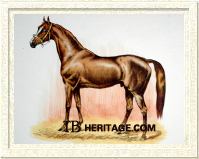
Trocadéro
| |
TROCADÉRO (1864), cursed with a fretful, and later almost savage temperament, was probably Monarque's next best running son, after GLADIATEUR. He strongly resembled Monarque, except for the chestnut coat inherited from his dam, Antonia (by Epirus). Like his sire, a durable and versatile racehorse that could stay and carry weight, he ran to age six in France, England, and Germany, winning at all distances and retiring sound. It was believed he was the son that would carry on Monarque's line in France, and he did get many good runners in a somewhat truncated stud career that seemed to assure he would be the son to continue it. But after the first generation, he was not the Monarque son to influence bloodstock in future generations.
|
TROCADÉRO, bred and raced by Lagrange, was one of the three best of his generation at age three, along with Monarque's son PATRICIEN, owned by Henri Delamarre, and Fervacques, by Underhand, owned by Auguste de Montgomery. He was unplaced in England's Two Thousand Guineas, but in France won the Prix de l'Empereur (later Prix Lupin) over 2,100 meters at Longchamp, beating Jeune-Première, who went on to win the French Oaks. He ran second to PATRICIEN in the Prix du Jockey Club, and then third in Grand Prix de Paris, behind Fervaques and Patricien. His next race was an easy win in the Saint-Léger at Moulins. In Germany he beat Patricien in both the Saint-Léger Continental and the Poule des Produits, both at Baden-Baden. He ran second to Patricien in the Grand Prix du Prince Impérial (Prix Royal Oak). He was sent with other Lagrange runners to England, where he won two biennials at Brighton.
In 1868 Trocadéro won the Grosser Preis von Baden-Baden (actually, a dead-heat with Nèlusko, also owned by Lagrange, who declared for Trocadéro); races at Fontainebleau and Deauville, the Prix de Chantilly, the Prix de Jouvence at Longchamp, the Prix Impérial and the Grand Prix de la Ville at Marseille. He ran second to LONGCHAMP, also by Monarque and owned by Lagrange, in the Grand Prix de l'Impératrice (Prix Rainbow) and the Prix de Seine-et-Marne, and was second to yet another Lagrange-owned son of Monarque, AUGUSTE, in the Grand Prix de l'Empereur (Prix Gladiateur).
At age five, 1869, Trocadéro's wins included the Coupe, in Paris, beating Mortemer, a winner of 9 races that year; the Prix Rainbow over 5,000 meters, and the Prix Gladiateur over 6,000 meters (both races having been recently re-named) and, in England, Epsom's Walton Manor Stakes.
In his final year of racing he won the Prix Rainbow for a second time, and was taken to England to run unsuccessfully in the Ascot Gold Cup, but he did win the Queen Alexandra Stakes there. He stayed in England, and, like GLADIATEUR, was included in the lot the count sent to Tattersall's for public auction. He sold for 36,750 francs (Gladiateur brought 152,250 francs, and Mortemer 86,625 francs), purchased by Henry Woolcott, at Beckhampton, trainer of the triple-classic winning filly, Formosa.
Paul Aumont, who had rebuilt Haras Victot after his father's death, set out to bring Trocadéro back to France, intending to cross him with Gladiator-descended mares; Aumont was a believer in in-breeding, and by the early '70s a third of his broodmare band consisted of mares saturated with Gladiator blood. Trocadéro seemed a natural choice as an outcross stallion. In 1871, he found Trocadéro in Manchester, where he had been sold by Woolcott; his legs had been pinfired, and his new owner was training him as a steeplechaser, and never a very stable horse mentally, he had become extremely hard to handle. Aumont promptly paid 30,000 francs for the horse, and shipped him back to France. Landing at LeHavre, horse experienced some roughing up on the quay because Trocadéro had the initials "P.N." on his blanket, causing onlookers to conclude he was a horse belonging to Prince Napolèon, and instigating a minor riot, during which a stable boy accompanying the horse was seriously bitten and trampled. Arriving at Victot, he savaged a stud groom. For a while he spent time in a narrow stall with a specially designed iron face plate and muzzle: he became known as the "horse in the iron mask." Eventually Aumont found a trainer in Paris, named Carrier, who was able to school the poor animal relatively kindly into a mesured sort of tractability. Trocadéro stood at Victot until 1881, dying at age seventeen.
Trocadero's first crop began racing in 1875, and the last offspring ran in 1887. Over a span of twelve years his offspring won over 400 races and three million francs, many of them stayers. His best was probably Madamoiselle de Senlis, the best juvenile of 1881, at age three winner of the Prix de Diane (French Oaks) and Prix Daru, and at age four winner of la Coupe de Paris, the Prix de Longchamp at Deauville, the Prix de Jouvence and the Prix Gladiateur. She bred on, producing a daughter, Mademoiselle de Longchamps, another stayer that won the Prix Gladiateur, who bred on: Durban Gold Cup winner Le Vin Chaud (1927) descended from her.
Other good ones by Trocadéro included Silex (Prix de Longchamp, later Prix Hocquart), Extra (also Prix de Longchamp); Bariolet (Prix du Cadran, Prix du Printemps, Prix de Dangu, Prix Gladiateur, and Prix Rainbow); Pourquoi (Prix Gladiateur, and other races); Satory (Prix Rainbow). Another Trocadéro son, Fra Diavolo, was the best juvenile of his generation, winning the Prix de Villiers, the Grand Criterium, and the Prix de la Salamandre, and later won the Coupe de Paris and the Grand St. Leger de France. Fra Diavolo was later sire of Solitaire, winner of the Grand Steeple-Chase de Paris. Another son, Narcisse, placed well in some races at age three, including the prix d l'Espérance, and was later the sire of Prix du Jockey Club winner Chene Royal.
PATRICIEN (1864), from another Gladiator mare, Papillotte, was owned by Henri Delamarre. He had a brilliant three-year-old season, winning the Prix de Longchamp (Prix Hocquart), the Prix du Jockey Club, and Grand Prix du Prince Imperial (Prix Royal Oak), the Grand Prix de la Ville at Marseille, and dead-heated with Fervacques in the Grand Prix de Paris, losing the run-off. He also ran second to Ruy-Blas in the Grand Prix de Bade. He broke down at the end of the season. He was later a modest sire for Haras de Chamant; one of his sons, Vésuve, won the Prix de Longchamp (Prix Hocquart).
Another Monarque colt of 1864 was LONGCHAMP, a brother of AUGUSTE'S, from Étoile du Nord, bred and raced by Lagrange. Overshadowed by Trocadéro, Patricien and Fervaques, he did not shine until he hit age four, although at age three he did win the Newmarket Derby in England, beating Derby winner Hermit (who conceded 14 pounds). At age four he won the Prix du Cadran and the Grand Prix de l'Impératrice (Prix Rainbow), and at age five his victories included the Prix de Dangu and the Prix de la Ville at Fontainebleau. Another 1864 colt was CERF-VOLANT, a brother to Hospodar from Sunrise; he won the Poule des Produits (Prix Daru) for Lagrange at age three.
There were several Monarque daughters in the 1864 crop that were good producers. METALLIQUE (from Payment, by Slane, and so half-sister to the great stallion Dollar) became the dam of the colt Metallist (1881), a winner of the Trial Stakes in England, and later a good winner in Hungary. FLEUR DE LIN (from Ravieres, by Nuncio or Bataclan) bred on, and OUVREUSE (from Ouverture, by Silvio) was tail-female ancestress of the great Argentinian runner Pelayo (1902) and of the French crack and later good stallion, Maintenon (1903).
The big winner for Monarque in the 1865 crop was LE SARRAZIN, out of Constance, and so brother to FIDÉLITÉ, LA FAVORITE and L'AVENTURIERE. He won Epsom's Woodcote Stakes in England as a juvenile. The next year he won the Prix du Cadran and the Prix de l'Empereur and the Prix des Pavillons. He had an accident in 1869 and did not race that year, and did not do much after. At stud at Haras Dangu, he got some good runners, including Milan, winner of the Newmarket Derby in 1880, and Prix du Cadran, the Prix Rainbow and the Prince of Wales's Stakes at Newmarket in 1881. He also got Prix Gladiateur winner Figaro.
Other winners from the 1865 crop included Liouba's son LE BOSPHORE, winner of the Prix de Longchamp (Prix Hocquart); NÉLUSCO (from Margaret, by Drayton), winner of the Grand Prix du Prince Impérial (PrixRoyal Oak); and OURAGAN (out of Sunrise, and so brother to HOSPODAR), who won the Poule des Produits (Prix Daru) for Lagrange. A Monarque daughter from this crop, SELIKA, a half-sister to Prix Hocquart winner Allez-y-rondement (by The Emperor's son Allez-y-gaiment), established a nice female line that included winners in Chile, France, South Africa, and Italy.
|
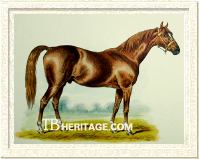
Consul
| |
In 1866 Monarque's son CONSUL was born at Haras Dangu. He was a small chestnut colt, out of the Sir Hercules mare Lady Lift, and so a younger brother to LE MARECHAL. At age two he won the Premier Critérium and lost the Prix de la Forêt due to jockey error. At three he lost the Prix de Longchamps by a head to Monarque's son PANDOUR, but went on to win the Poule d'Essai, beating Eckmüt and Cerdagne; the Prix de Guise, and then the Prix du Jockey Club, beating Cerdagne, PANDOUR (who was favored to win), Glaneur, and other good ones. In the Grand Prix de Paris he could only run fourth, behind the winner Glaneur and two English horses, The Drummer and Ryshworth, but he won the Prix de Seine-et-Marne.
|
CONSUL was a good sire, whose offspring included Albion, winner of the Poule des Produits (Prix Daru) and the Prix du Jockey Club, and his brother Archiduc, who won Newmarket's Criterion Stakes at age two, and at ages three and four also the Poule des Produits (Prix Daru), as well as the Poule d'Essai des Poulains, the Prix du Cadran, the Prix Royal Oak, and the Prix Rainbow. Archiduc was later a sire in Joachim Lefèvre's stud. CONSUL also got Kilt, who won the Prix du Jockey Club, the Prix Royal Oak and the Prix Rainbow for Baron Alphonse de Rothschild, and the good stayer Nougat, who won the Prix Rainbow and Prix Gladiateur for Lagrange. It was through Consul's son, Fripon (1883), who did nothing on the turf, that the Monarque sire line continued: Fripon was the great-grand sire in tail-male of the outstanding runner Sardanapale, winner of the Prix du Jockey Club and Grand Prix de Paris, among other races, and twice leading sire in France. Sardanapale's good running son, Apelle, was also a leading sire in France.
Other members of Monarque's 1866 crop included the aforementioned PANDOUR (from Malice, by Iago), whose wins included the Prix de Longchamp (Prix Hocquart), and BOULOGNE (from Miss Ion, and so brother to BEATRIX and HENRY), winner of the Grand Prix de la Ville in Lyon and of the Newmarket Derby in England in 1869, and of the Prix du Cadran and the Bentinck Memorial at Stockbridge, England.
Monarque's daughters born in 1866 included APPARAITION (from Adulation, by Newminster), who bred St. James, winner of the Prix du Jockey Club and not much else, and two daughters who continued her female line; Pric du Jockey Club winner Mouktar (1982) was a descendant in tail-female of Apparition. Another daughter born this year was Blanche (out of Constance, and so sister to LE SARRAZIN, LA FAVORITE, and the rest), who established a nice female line of winners in Poland.
The best runner by Monarque born in 1867 was DON CARLOS (from Noelíe, by The Baron). He won the Criterium at Bordeaux as a juvenile, and the next year won the Prix de la Néva, the Grand Prix de Bourgogne, the Caen Handicap, and four plates in England. Another son, VALOIS (from Bourg la Reine, by The Cossack), won the Poule d'Essai des Poulains.
In 1868 Monarque had two good colts born: HENRY, from Miss Ion, and GÉNÉRAL, who was out of the Valbruant mare, Tolla. GÉNÉRAL ran for Lagrange in England at age two, winning Goodwood's Lavant stakes and Molecomb Stakes; Lagrange then sold him to the Duke of Hamilton for the huge sum of 99,750 francs. For Hamilton Général failed in the July Stakes, but won Newmarket's Criterion Stakes. He failed to train on with any success. HENRY was a much sturdier proposition. Purchased by Joachim Lefè in the Haras Dangu Tattersall's sale in London in 1870 as a juvenile for 35,437 francs, he won the Ascot Derby and the Newmarket Derby at age three, and, as noted earlier, the Ascot Gold Cup and the Prix Rainbow at age four. Of the fillies born that year, ESPERANCE (out of Sunrise, and so sister Hospodar and the rest) became an ancestress of the Grand National Steeplechase winner Freebooter (1941), and TOUCQUES, out of the great race mare La Toucques, had winning tail-female descendants through the late twentieth century.
Monarque's 1869 crop included one of his best running daughters, REINE, from the great Fille de l'Air. Reine was taken to England by Joachim Lefèvre, where she triumphed in both the One Thousand Guineas and the Epsom Oaks. That was it for her, however: in the Prix de Diane she ran second to Little Agnes, and was third in both the Grande Poule (Prix Lupin) and the Grand Prix de Paris (won by Cremorne). She later produced Regain, winner of the Poule d'Essai des Poulains and the Prix du Cadran, and a couple of daughters that bred on for a few generations. Also born this year was PROMISE, from another good race mare, Prix de Diane winner Mademoiselle de Chantilly (by Gladiator). Promise may not have raced, but in the stud she produced two good daughters, Ismenie (by Plutus), dam of the winners Acheron, Phlegethon and Cérebe, and Urgence (by Dollar), who produced Ascot Gold Cup winner Maximum. Promise's younger brother, NOVATEUR, born in 1871, won the Poule d'Essai des Poulains, and, in England, the City and Suburban Handicap.
Monarque's crop of 1870 was very small, impacted as it was by the Franco-Prussian War, as was the 1871 crop. In addition to NOVATUER, the 1871 crop included FEU D'AMOUR, who ran in England, winning the Clearwell and Prendergast Stakes at Newmarket as a juvenile. Monarque's last crop, born in 1872, was also small, but included LAVERSINE and REINE's sister, FILLE-DU-CIEL, who won the Prix Salamandre at age two. LAVERSINE, from the Stockwell daughter, Voluptas, was second dam of the French crack Le Roi Soliel (1895, by Heaume), winner of the Grand Prix de Paris, Prix Royal Oak, and other good races.
In 1893 the Prix Monarque for three-year-olds was established at Maisons-Laffittee, Paris, held over a distance of 2,000 meters, in which winners of previous races were heavily handicapped. The name of the race was changed, however, in 1911 to Prix Eugène-Adam (now a Group II race), named after one of the owners of the course whose primary interest was steeplechasing, and at times has been run at various other venues. No matter. Monarque still has a place among the most influential horses to have lived in France.
--Patricia Erigero
|
|
|
|

